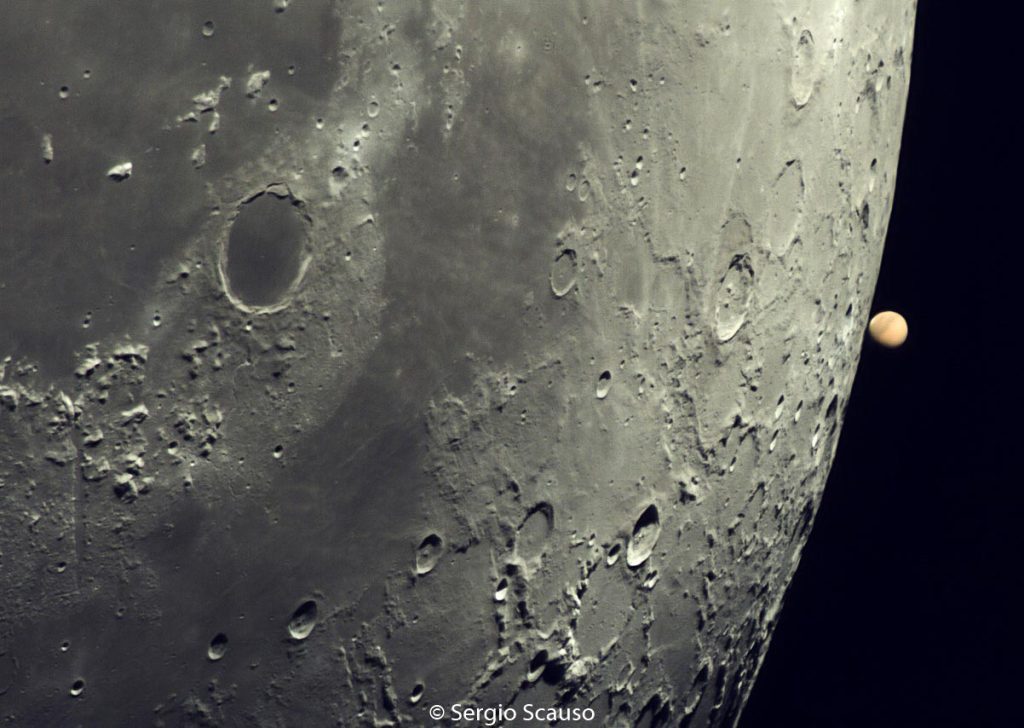La luna si sposta occasionalmente davanti a tutti i pianeti del sistema solare, compreso Marte. Credito: Sergio Cuzzo
Quali sono alcuni dei punti salienti dello skywatching nel dicembre 2022? Passa la luna[{” attribute=””>Jupiter twice this month, and actually covers Mars completely, in an event called an occultation, on December 7. The event is visible across the U.S., except for the Southeast and East Coast, where the Moon will graze closely past Mars. And throughout the month, you can find Pegasus, the winged stallion, high overhead in the south.
Cosa cercare nel dicembre 2022: Marte scompare e Pegasus parte per un’avventura. Gli spettatori di gran parte degli Stati Uniti e dell’Europa possono vedere Marte scivolare dietro la luna il 7 dicembre e tutti possono trovare la costellazione del cavallo alato Pegaso.
- 1 dicembre – Guarda a sud-ovest questa sera per trovare la Luna a poche dita di distanza dal luminoso Giove.
- 7 dicembre – la luna piena
- 7 dicembre La luna oscura Marte stanotte. Negli Stati Uniti, Marte sta scivolando dietro la Luna per gli spettatori ovunque oltre la costa orientale e il sud-est, dove sembrerà che la Luna passi appena oltre Marte. Controlla la tua app o sito Web preferito per osservare le stelle per sapere quando Marte scomparirà e riapparirà.
- 23 dicembre – nuova luna
- 25-31 dicembre – Controlla la luna e i pianeti alla fine dell’anno. Guarda ogni sera mentre la luna sempre più piena scivola via[{” attribute=””>Saturn on the 26th and then past Jupiter on the 28th.
- All month – Find the constellation Pegasus high in the south-southwest after dark. Look for bright Jupiter and find the Great Square of Pegasus about 15 degrees above it.

Lunar occultation of Mars. Credit: Andrés Jobacho
Video Transcript:
What’s Up for December? Your evening planet highlights, including the disappearance of Mars, and the constellation Pegasus.
The month begins and ends with the Moon visiting the giant planets. On December 1st, find the Moon just a couple of finger-widths apart from Jupiter in the evening sky. Then, from the 25th to the 31st, look to the southwest following sunset to see an increasingly full Moon slip past Saturn and then again past Jupiter. Viewers with a clear view to the horizon will be able to search for Venus and Mercury in the fading glow of sunset, just a few degrees above the skyline.
December 7 brings one of those magical moments when the sky changes dramatically before your very eyes. It’s called a lunar occultation, as the Moon passes in front of, or occults, the Red Planet, Mars. The spectacle will be visible in parts of North America, Europe, and Northern Africa. (Viewers in the Southeast and on the East Coast will see the Moon just graze past Mars.) For viewers in the U.S., Mars disappears behind the Moon sometime between about 6:30 and 9 p.m., depending on your location, so check your favorite skywatching app to find the time for your area.
Now, the Moon passes in front of planets in the night sky several times per year. In fact, it generally occults Mars itself at least a couple of times per year. But each occultation is visible from only a small portion of Earth’s surface, so it’s not super common for any particular spot on Earth to see them frequently.
Of course, the Moon passes in front of stars all the time. If you’re watching through binoculars, they just blink right out. But planets are not just points of light like stars – they appear as circular little disks, so planets actually take several seconds to disappear and later reemerge. So if you’re in the viewing zone, enjoy this relatively rare opportunity to watch a bright planet being occulted by the Moon.
Looking high in the southwest sky on December evenings, you can find a constellation named for one of the more fantastical beasts of ancient mythology. That’s Pegasus, the winged horse. In Greek myth, Pegasus rode into adventures with the hero Belaraphon, and later carried the thunderbolts of Zeus himself, who rewarded him by placing him among the stars.
Pegasus is one of the largest of the 88 constellations. Its most prominent feature, and the key to finding it in the sky, is this asterism, or pattern of stars, called the Great Square. These four stars of roughly equal brightness form the central part of the horse’s body.
This December, it’s easy to locate Pegasus, thanks to brilliant Jupiter. Face southward to find the giant planet about halfway up the sky, with the Great Square beginning about 15 degrees to the north of it.
Pegasus is a useful constellation for stargazers, as it’s a good starting place for finding your way to other features in the night sky. The constellation itself contains a number of dazzling deep-sky objects, including globular cluster M15, and the tangled galaxies of Stephan’s Quintet. With this year drawing to a close, here’s hoping you seek out the winged stallion Pegasus, as you ponder what new adventures await in the next year.
Here are the phases of the Moon for December.

The phases of the Moon for December 2022. Credit: NASA/JPL-Caltech
Stay up to date with all of NASA’s missions to explore the solar system and beyond at nasa.gov. I’m Preston Dyches from NASA’s Jet Propulsion Laboratory, and that’s What’s Up for this month.

“Giocatore. Aspirante evangelista della birra. Professionista della cultura pop. Amante dei viaggi. Sostenitore dei social media.”



/cdn.vox-cdn.com/uploads/chorus_asset/file/25407815/Screen_Shot_2024_04_18_at_4.13.30_PM.png)



More Stories
Risultati notevoli – Una nuova ricerca rivela che il midollo spinale può apprendere e memorizzare
In un contesto di incertezza sulla tempistica, Boeing licenzierà i lavoratori del programma missilistico SLS
Come il ciclismo mi ha aiutato a gestire il dolore